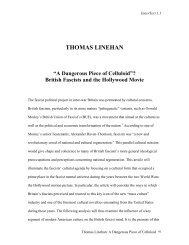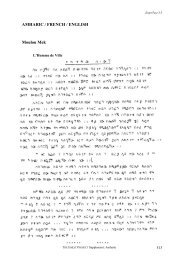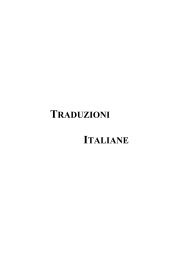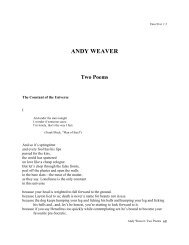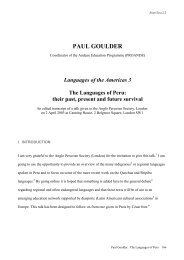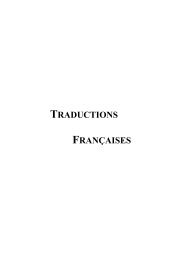Thomas Lamarre: An Introduction to Otaku Movement - Arts @ Brunel
Thomas Lamarre: An Introduction to Otaku Movement - Arts @ Brunel
Thomas Lamarre: An Introduction to Otaku Movement - Arts @ Brunel
Create successful ePaper yourself
Turn your PDF publications into a flip-book with our unique Google optimized e-Paper software.
EnterText 4.1<br />
terms of the scope and breadth of their activities in translating, introducing and promoting<br />
anime. In this simple way, the transnational otaku circuit potentially challenges the<br />
cultural hermeneutics and the complicit play of gazes that seem <strong>to</strong> dominate academic<br />
discussion of anime.<br />
Needless <strong>to</strong> say, the transnational otaku knowledge of anime does not<br />
au<strong>to</strong>matically escape the cultural hermeneutics that tends <strong>to</strong> govern the way in which<br />
Japan experts look at anime. As Okada points out, many non-Japanese otaku wish <strong>to</strong><br />
learn Japanese precisely because they feel they are missing something available <strong>to</strong><br />
Japanese viewers—and <strong>to</strong> cultural informants and experts. In other words, the<br />
Japanophile otaku confirms a loss in translation, allowing for cultural and linguistic<br />
expertise <strong>to</strong> fill the gap. Yet, if one takes seriously the notion of a distributive visual field,<br />
one would have <strong>to</strong> think the transnational movement of translation differently. If the<br />
anime image works as a media opening that lends itself <strong>to</strong> multiple media<br />
transformations, then the transformations of anime as it moves transnationally would<br />
have <strong>to</strong> be seen as part of the proliferation of its self-organising field. The appearance of<br />
similar attrac<strong>to</strong>rs and co-opera<strong>to</strong>rs outside Japan would come as no surprise. Is that not<br />
how the anime image is supposed <strong>to</strong> work? <strong>An</strong>ime may not be lost in translation but only<br />
opened. That is <strong>to</strong> say, it is less a matter of a loss of an original cultural meaning than a<br />
multiplication of meanings that were already implicit in or at least enabled by the<br />
layering of the original image. There is already a relation <strong>to</strong> American global culture in<br />
those images.<br />
It is imperative <strong>to</strong> think about how anime, as mass culture or subculture or fan<br />
cult, produces difference, how it strives <strong>to</strong> mark an au<strong>to</strong>nomous zone of anime activity<br />
<strong>Thomas</strong> <strong>Lamarre</strong>: <strong>Otaku</strong> <strong>Movement</strong> 182



